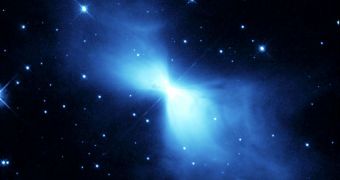Scientists at the European Southern Observatory (ESO) discovered in 1995 what was at the time believed to be the coldest object in the Universe. Using the Chile-based ESO Submillimeter Telescope, the experts looked deep in space, and identified the Boomerang Nebula, which featured temperatures as low as minus 272 degrees Celsius. This means that the entire stellar nursery is no more than 1 degree Celsius warmed than absolute zero, Space Fellowship reports.
This particular structure is not your average star-forming nebula. Usually the term applies to stellar nurseries, massive clouds of hydrogen gas and new stars. Inside, constant stirring by stellar winds and interacting gravitational forces collapse large gas clouds into freshly-formed blue stars, which go on to repeat the cycle of their predecessors. But the Boomerang is a planetary nebula, which is basically an emission nebula that features an expanding glowing shell of ionized gas and plasma. Its name was derived from the first observations of such a structure, conducted in the 18th century. Through the small optical telescopes available at the time, these formations looked like giant planets.
In this new image of the Boomerang Nebula, we are treated to new details about the structure. This particular photo was snapped by the Hubble Space Telescope, and is another testament to the amazing resolve power the scientific instruments aboard the famous observatory have. The Nebula itself is located some 5,000 light-years away, in the direction of the Centaurus Constellation. What is tremendously interesting about it is that it's even colder than the cosmic microwave background (CMB), the afterglow left behind from the time when the Big Band exploded the Universe into being.
In this 1980 image, we see that the lobes of the nebula have yet to develop the bubble-like appearance that other similar structures have, which would appear to indicate that it is very young. In addition, a central star is also visible here, most likely in its dying throes. Stellar winds traveling at speeds in excess of 500,000 kilometers per hour are most likely responsible for the general shape of the Boomerang Nebula, researchers hypothesize. The star is believed to be losing mass for at least 1,500 years, and astrophysicists say that the equivalent of one thousandth of a solar mass is being emitted each year. This allows for the nebula to expand very rapidly, and become incredibly cool.

 14 DAY TRIAL //
14 DAY TRIAL //